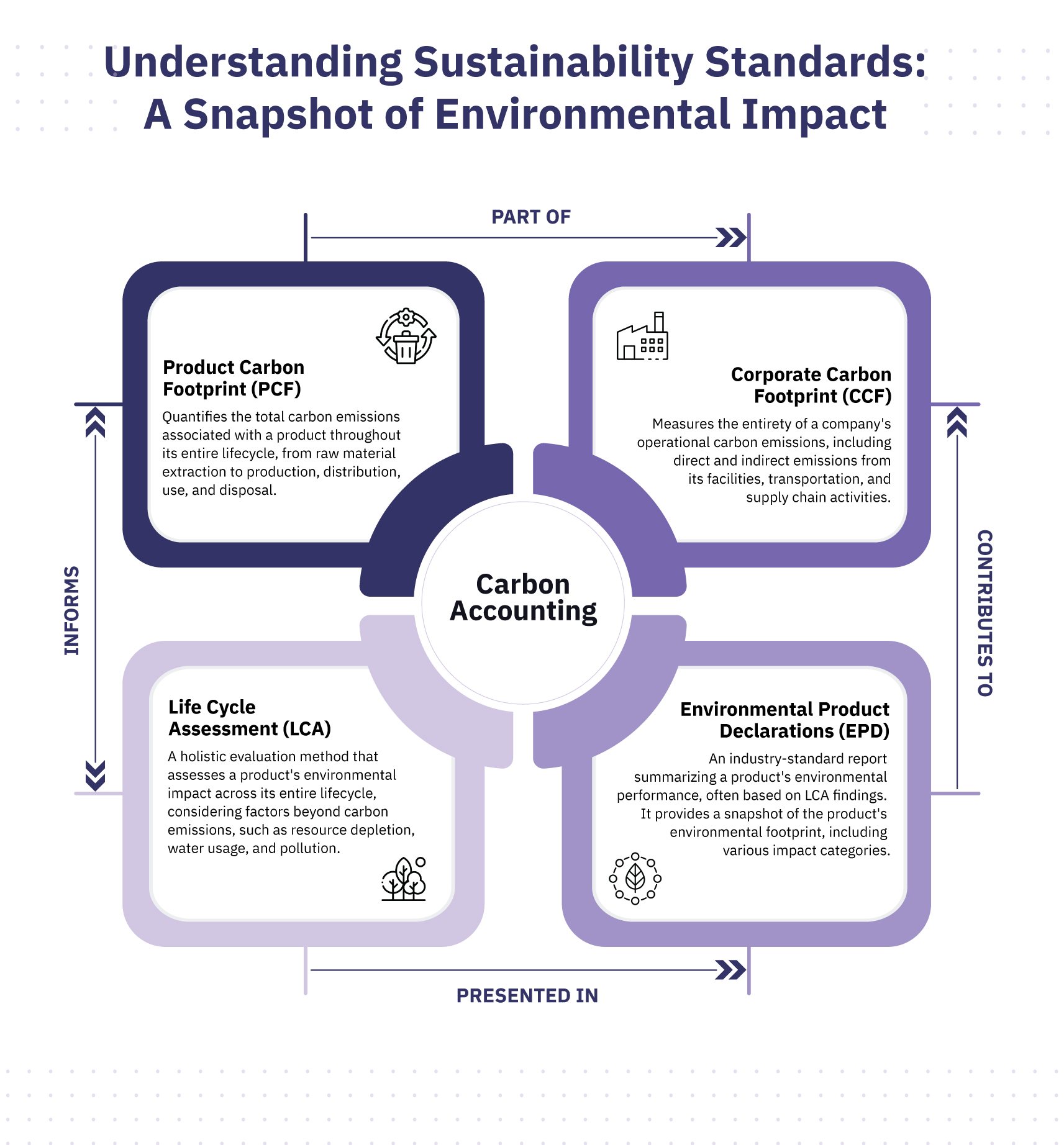Key takeaways
- Corporate Carbon Footprint (CCF): Encompasses the totality of a company’s operational emissions.
- Product Carbon Footprint (PCF): Highlights carbon emissions tethered to an individual product’s lifecycle.
- Life Cycle Assessment (LCA): A holistic evaluation of a product's environmental impact, including but not restricted to carbon.
- Environmental Product Declaration (EPD): An industry-standard report providing a snapshot of a product’s environmental footprint, frequently anchored in LCA findings.
- Corporate Carbon Footprints (CCFs), Product Carbon Footprints (PCFs), Life Cycle Assessments (LCAs) & Environmental Product Declarations (EPDs) are essential tools for measuring and reducing greenhouse gas emissions across company operations.
- Read on more to find out what they're about.
Introduction
In my two decades in the tech industry, I became intimately familiar with its language, full of acronyms that often baffled the uninitiated. Now, with the understanding of better-optimised customer engagement, I've discovered a similar fascination for acronyms in the world of sustainability. This isn't just a quirk of these industries; it signifies the continuous evolution of new concepts, trends, and technologies – something that both the IT and sustainability industries have in common
In this age of digital transformation, the lexicon of sustainability is becoming as crucial as any programming language. Businesses and consumers alike are becoming progressively attuned to the importance of green practices.
According to the Harvard Business Review, 72% of companies see climate change as a significant risk to their business operations, revenue, and costs. At the same time, a study in the Stanford Social Innovation Review reveals that over 90% of CEOs consider sustainability crucial for their company's success. As for the customers’ opinion, according to a study by Accenture, 83% of consumers think it's crucial for companies to design products for reuse or recycling, while a survey from Simon-Kucher indicates that 78% of people consider environmental sustainability important and express a desire to lead more sustainable lives.
With the merger of technology, corporate responsibility, and sustainability, we're faced with an extensive list of acronyms. But what do these terms signify for your business and our planet? Join me, as I aim to elucidate these acronyms, offering business leaders a clear roadmap to navigate their sustainability responsibilities. Let’s dive in.
Telling Your Acronyms Apart
To simplify, here is how to distinguish between CCF, PCF, Life Cycle Analysis (LCA) and Environmental Product Declaration (EPD):
- CCF: Encompasses the totality of a company’s operational emissions.
- PCF: Highlights carbon emissions tethered to an individual product’s lifecycle.
- LCA: A holistic evaluation of a product's environmental impact, including but not restricted to carbon.
- EPD: An industry-standard report providing a snapshot of a product’s environmental footprint, frequently anchored in LCA findings.

In today’s world, many companies are leading the charge in these areas by adapting and implementing innovative strategies in decarbonisation. Among them are:
|
Unilever |
Unilever, a multinational consumer goods company, has long been committed to sustainability. The company has been actively reducing its CCF by implementing sustainable sourcing of raw materials and streamlining its manufacturing processes for increased efficiency. They are also committed to sourcing 100% renewable electricity for their operations. |
|
Patagonia |
Patagonia, an outdoor clothing and gear brand, is renowned for its commitment to environmental responsibility. 87% of Patagonia apparel contains recycled material. Patagonia uses LCA to ensure its products are designed and produced with minimal environmental harm. The brand is also known for its dedication to transparency, revealing its supply chain practices to the public. |
|
Tesla |
Tesla, primarily known for its electric cars, is at the forefront of the green revolution in the automotive industry. Unlike traditional automakers that rely on fossil fuels, Tesla's approach to manufacturing prioritises reducing its carbon footprint. Although not explicitly stated, the company's approach to revealing details about its battery recycling program and push towards 100% renewable energy aligns with the principles of EPD – transparency in how products are made and their environmental impact is crucial in today's eco-conscious market. |
|
Adidas |
Adidas, the global sportswear giant, has been making strides in sustainable product innovation. The company has been keen on measuring and reducing the PCF of its products. By using materials like recycled polyester, Adidas aims to decrease the carbon footprint associated with each pair of shoes or clothing item they produce. In recent years, Adidas launched eco-friendly product lines, such as shoes made from ocean plastic. |
Corporate Carbon Footprint (CCF)
One of the pivotal concepts in corporate sustainability is CCF, which stands for Corporate Carbon Footprint. CCF represents the total greenhouse gas (GHG) emissions a company or organisation produces, encompassing both direct and indirect emissions. Understanding the climate impact of its operations is instrumental for any business aiming to make genuine strides in sustainability.
CCF stems from various sources and activities within an organisation which can be categorised into two principal groups: Direct emissions, also referred to as primary footprints or scope 1 under the GHG Protocol, originate from sources that an organisation controls or owns. Indirect emissions, known as secondary footprints, are further divided into scopes 2 and 3 under the GHG Protocol - these emissions arise from activities indirectly associated with the organisation.
Scope 3 emissions occur outside of a company’s direct control, in their value chain. Scope 3 carbon emissions represent the majority of the carbon footprint for most companies, in some cases as high as 85% to 95%, says CNBC. Collating precise emissions data, especially for Scope 3 spanning an enterprise’s entire supply chain, is a challenging feat. The CDP reported that only 41% of businesses have disclosed information on at least one Scope 3 emissions category.
Worldwide, various jurisdictions, including the European Union (EU), have enforced the obligation for businesses to report climate-related information. Embracing the ambitious European Green Deal, the EU has committed to decrease its overall greenhouse gas emissions by 55% by 2030. To realize this objective, the EU has sanctioned the Corporate Sustainability Reporting Directive (CSRD), commencing in January 2024. This new regulation will require companies to divulge information regarding their sustainability performance. A growing number of countries, such as the United States, Singapore, and Australia, are moving to implement similar mandates.
As a result, there is a notable uptick in the demand for carbon accounting, which involves the measurement, documentation and reporting of greenhouse gas (GHG) emissions generated by an organisation or enterprise. This is facilitated through management tools and customised consulting services. Comprehensive CCF has become the linchpin for developing effective sustainability initiatives and mitigating climate impact.
Embracing the CCF metric within your operations isn't just about adhering to sustainability regulations and trends; it's about harnessing an invaluable tool that can redefine your business trajectory. A transparent and meticulous assessment of your CCF not only builds trust among stakeholders and consumers but positions your company as a forward-thinking entity that is truly committed to meaningful sustainability.
Moreover, by aligning with regulatory standards, you not only protect your company from potential liabilities but also place it in a favourable position to benefit from various incentives.
|
Access to capital |
Transparent CCF disclosure is an integral part of your company’s sustainability disclosures. Increasingly, environmentally-savvy investors consider these disclosures when making investment decisions. |
|
Trust & reputation boost |
Accurate CCF tracking and reporting can enhance your corporate image, making your business more attractive to eco-conscious consumers and partners. |
|
Regulatory compliance & incentives |
By effectively managing your CCF, you are not just meeting the minimum requirements but positioning your business to tap into potential incentives, such as reducing your carbon tax bill. |
|
Operational efficiency & cost savings |
Addressing cost and operational qualms will not only reduce your carbon footprint but can also translate into significant cost savings, offering a dual benefit of environmental responsibility and economic efficiency. |
The adoption of CCF has already brought various developments to the industry, with numerous companies facilitating sustainability measures.
|
Maersk |
Recognising the considerable CCF from shipping, Maersk has pledged to achieve carbon neutrality by 2050. To do this, they've been exploring biofuels and investing in innovative carbon-neutral shipping solutions. |
|
Nestlé |
As part of its efforts to combat climate change, Nestlé has worked to map its full supply chain to understand its Scope 3 emissions better. They are taking active steps to reduce CCF by aiming for net zero emissions by 2050, which includes making their 800+ sites around the world carbon neutral. |
|
L'Oréal |
L'Oréal has committed to a L'Oréal for the Future program, aiming for all of its sites to achieve carbon neutrality by improving energy efficiency and using renewable energy. They have particularly focused on understanding their CCF across all scopes to drive these initiatives. |
Such companies and their tangible initiatives showcase the potential of tech-driven approaches to tackle and manage CCF effectively.
Product Carbon Footprint (PCF)
The GHG Protocol Product Standard and ISO 14067 are two internationally recognised standards for quantifying and reporting the GHG emissions associated with products. They both provide a framework for companies and organizations to identify, measure, and report on the GHG emissions that occur throughout the entire life cycle of a product, from raw material extraction to end-of-life disposal.
Both standards are based on the principles of life cycle assessment (LCA), which is a methodology for evaluating the environmental impacts of products and processes throughout their entire life cycle. LCA considers all of the environmental impacts of a product, from resource extraction to end-of-life disposal, including GHG emissions.
Stemming from these frameworks, PCF decodes the carbon emissions generated during the entire lifecycle of a specific product, from raw material to its end of life.
When it comes to PCF, there are different types of assessments to consider:
- Cradle to Gate: This covers the carbon footprint from the raw material stage up to the point reporting company’s gate (including upstream transportation). It excludes downstream emissions from product use and end-of-life.
- Cradle to Grave: This is a comprehensive assessment that includes all stages from raw material extraction through to disposal.
- Cradle to Cradle: This approach goes beyond Cradle to Grave by also considering how materials can be recycled or reused, aiming for a closed-loop system where waste is minimised or eliminated. This concept ties into the idea of "circularity," which aims for products and materials to be used for as long as possible through recycling, refurbishment, and eventually remanufacturing.
There are various hurdles an enterprise has to solve before committing to this. Among them are the complexity of supply chain traceability from origin to disposal and the absence of a universal standard for PCF calculation.
Nonetheless, PCF reporting is gaining popularity among businesses as an evolving eco-aware consumer base demands transparency in the carbon credentials of their purchases. A recent report by First Insight and the Baker Retailing Center at the Wharton School of the University of Pennsylvania found that Gen X consumers have seen a nearly 25% increase in their preference for sustainable brands. Across all generations, the willingness to pay a premium for sustainable options has grown significantly, with nearly 90% of Gen X consumers now willing to spend an extra 10% or more, compared to just 34% two years ago.
Due to this, businesses also get to stand out among their competitors by offering eco-advantageous products. A study by Visual GPS and YouGov reveals that the pandemic has influenced consumer expectations, with 81% of those surveyed now expecting companies to demonstrate environmental consciousness in their advertising and communications.
Technology and AI offer several avenues to assist with PCF calculations and reporting. LCA software can automate the modelling and estimation process at scale from raw materials to disposal, streamlining the complexity of PCF determination. AI-powered analytics can scrutinise supply chain data to identify carbon-intensive stages, thereby helping to optimise for lower emissions. Additionally, blockchain technology can establish a transparent and verifiable traceability system for each product's carbon footprint.
Further looking to the future, there are plans to ensure a broader implementation of PCF, especially in the EU. The Digital Product Passport (DPP) is an initiative under the European Green Deal. Slated for implementation in 2026 for the apparel, batteries, and consumer electronics sectors, the passport will require businesses to provide detailed information on both finished products and their individual components. The DPP enables consumers to make informed, eco-friendly purchases via QR code scans while providing businesses with detailed data to improve environmental performance and make more accurate sustainability claims.
Many companies are tracking their PCF and implementing it in their sustainability efforts. Examples are:
|
Levi Strauss & Co. |
The iconic denim brand has taken notable steps towards understanding its PCF. Recognising that producing one pair of Levi's 501 jeans results in significant emissions, they've worked on initiatives to reduce material, water and energy used in production. They work with a variety of organisations such as the Better Cotton Initiative (BCI), which focuses on decreasing the environmental impacts of cotton. By understanding and reducing their PCF, they aim to gain more insight in production and provide more visibility towards their eco-conscious consumers. By the end of 2020, 83% of their cotton was sourced sustainably from BCI farmers, organic cotton farms, or recycled cotton suppliers, with a target of reaching 100% by 2025. |
|
Unilever |
Known for its diverse range of products, Unilever has been proactive in calculating the PCF of its products. They've initiated "carbon rainbow" efforts, looking at ways to replace carbon derived from fossil fuels in their product ingredients with renewable or recycled carbon. |
|
IKEA |
The furniture retailer has been focusing on reducing the carbon footprint of its products. From sourcing sustainable wood to promoting products that help consumers reduce waste and save energy, IKEA’s PCF initiatives are central to its broader sustainability and climate-positive mission. |
Life Cycle Assessment (LCA)
LCA is a systematic approach used to evaluate the environmental impacts of a product, service, or process throughout its entire life cycle, from raw material extraction to production, use, and disposal. LCA provides a comprehensive view of environmental effects and can inform strategies to reduce a product’s overall carbon footprint.
Examples of companies using LCA include:
|
Ford Motor Company |
To understand the environmental impact of their vehicles, Ford has implemented LCA studies. This includes understanding the carbon footprint from material extraction, vehicle production, usage, and eventual recycling or disposal. |
|
H&M |
As a part of its sustainability initiative, this fashion retailer has integrated LCA into its production process to better understand and reduce the environmental impact of its clothing items from raw material to final product. |
|
Procter & Gamble (P&G) |
P&G uses LCA as a tool to understand the environmental footprint of its vast array of consumer products. This knowledge has driven more sustainable choices in package design and sourcing. |
Environmental Product Declarations (EPD)
Last but not least, Environmental Product Declarations (EPD) are standardised reports that provide quantifiable environmental data about a product, based on its LCA. EPDs offer a transparent way for businesses to communicate the environmental impact of their products to consumers, regulators, and stakeholders. Despite their importance, challenges in EPD creation include the time and resources needed for comprehensive LCA, and the lack of global standardisation which can lead to inconsistent reporting. Blockchain technology can be employed to provide transparent and immutable records for EPDs, while AI-driven platforms can analyse existing EPDs to suggest potential areas for improvement in environmental performance. Both of these technologies can streamline the creation and utilisation of EPDs, making them more accessible and reliable.
Examples of companies include:
|
Skanska |
This global construction company has been pioneering the use of EPDs for their construction products and services. They use EPDs to highlight the sustainable nature of their construction methodologies and to communicate the environmental impact of their buildings to clients and partners. |
|
Volvo Cars |
In its commitment to transparency and sustainability, Volvo Cars has used EPDs to communicate the environmental footprint of its vehicles, considering all stages from material sourcing, and manufacturing, to eventual vehicle end-of-life. It also launched a website specifically for its EPD. |
|
Electrolux |
This home appliance manufacturer has adopted EPDs to communicate the environmental performance of their products, ranging from refrigerators to washing machines. The declarations serve to both inform consumers and drive internal improvements. |
Conclusion
The fusion of technology, corporate responsibility, and sustainability has given rise to a landscape filled with acronyms, each representing a critical aspect of our journey toward a more eco-conscious future. From CCF to PCF, LCA, and EPD, these acronyms serve as guideposts for businesses navigating the complexities of sustainable practices.
The demand for carbon accounting is escalating, emphasising the importance of measuring and reporting greenhouse gas emissions comprehensively. As businesses strive to meet sustainability goals in an evolving global landscape with reporting standards like the CSRD and ISSB, understanding and reducing Scope 3 emissions becomes paramount.
Moreover, businesses embracing PCF, like Levi Strauss & Co., Unilever, IKEA, and others, showcase the tangible benefits of aligning with eco-friendly practices, gaining regulatory compliance, more trust, reputation enhancement, operational efficiency, and cost savings. As consumers increasingly value sustainability, businesses that embrace these acronyms not only meet current expectations but also position themselves as leaders in a conscientious market.
In the realm of PCF, technology and AI offer solutions to navigate complexities, with the EU's Digital Product Passport initiative standing as a visionary step toward standardised PCF reporting. Companies like Skanska, Volvo Cars, and Electrolux exemplify the successful integration of EPD, providing consumers with transparent insights into a product's environmental impact.
Ultimately, these acronyms are not just industry jargon; they represent a commitment to a sustainable future. As we witness the achievements of companies like Unilever, Patagonia, Tesla, and Adidas, it becomes evident that these practices are not only environmentally responsible but also economically viable. Thus, the decoding of these acronyms becomes not only a business necessity but a transformative journey toward a more sustainable and resilient world.

Felipe Daguila
Chief Customer Officer, Terrascope
Felipe is an accomplished global business and technology leader with a 25+ year record of leading, designing and delivering transformative business and digital strategies for startups, Fortune 500 companies (including Google and AWS), and now Terrascope.



